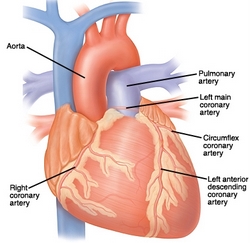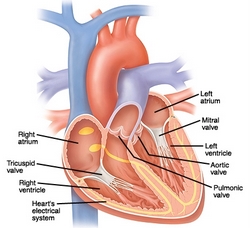Heart – How It Works
Your heart is a pumping muscle that works nonstop to keep your body supplied with oxygen-rich blood. Signals from the heart’s electrical system set the speed and pattern of the pump’s rhythm. Valves keep the blood moving in one direction, through the heart’s four chambers.
The aortacarries oxygen-rich blood to the body.
The right coronary artery supplies blood to the bottom, right side, and back of the heart muscle.
The pulmonary artery pumps blood to the lungs.
The left coronary artery supplies blood to the front, left side, and back of the heart muscle. It has three parts:
- Circumflex coronary artery
- Left main coronary artery
- Left anterior descending coronary artery
The right atrium receives blood from the body.
The tricuspid valve prevents blood from returning to the atrium.
The right ventricle pumps blood to the lungs for oxygen.
The heart’s electrical system is made up of nodes and pathways.
The left atrium receives oxygen-rich blood from the lungs.
The mitral valve prevents blood from returning to the atrium.
The left ventricle pumps oxygen-rich blood to the body.
The aortic valve prevents blood from returning to the ventricle.
The pulmonic valve prevents blood from returning to the ventricle.


